Plants
Orchid Care Guide: Tips for Healthy Blooms
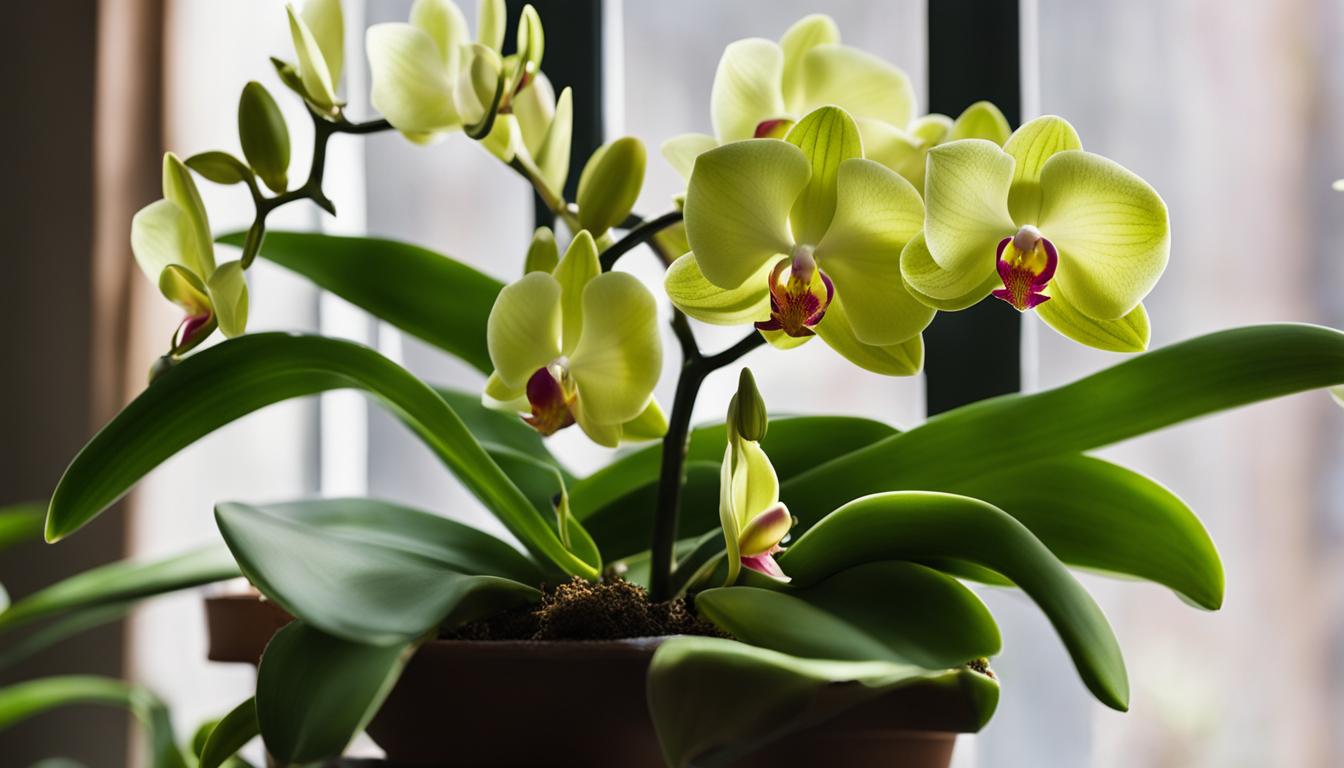
Welcome to our comprehensive orchid care guide! If you’re new to caring for orchids or looking to improve your skills, you’ve come to the right place. Orchids are stunning flowers that can add elegance and beauty to any home or garden. With the right care, they can bloom for months and bring joy year after year. However, orchid care can be a bit different from other plants, so it’s important to have some basic knowledge to ensure your orchids thrive.
First, it’s important to understand the natural conditions in which orchids grow. Some orchids are epiphytic, meaning they grow on other plants or trees, while others are terrestrial, growing in the ground. This knowledge will help you provide the right care for your specific orchid species.
Proper watering is key to orchid care. Orchids should be watered regularly but not excessively. It’s best to water them once a week by running water over the roots and potting mix, allowing the water to drain thoroughly. This mimics their natural environment and ensures the roots don’t become waterlogged.
Positioning your orchids in the right spot is crucial. They need bright, indirect light to thrive. Placing them in a bright windowsill, preferably east or west-facing, is ideal. Avoid placing them in direct sunlight or in drafty areas.
Feeding your orchids with orchid fertilizer is another important aspect of care. Weekly feeding with a specialized fertilizer designed for orchids will provide the nutrients they need to grow and bloom. Follow the instructions on the fertilizer package for the best results.
Lastly, repotting your orchids when they stop blooming is essential for their long-term health. Orchids should be repotted every 1 to 2 years in a larger container with fresh potting mix. This allows them to have enough space for root growth and ensures proper drainage.
With these basic care tips, you’ll be well on your way to successfully caring for your orchids. Remember, each orchid species may have specific care requirements, so it’s always helpful to research your particular orchid or consult with a knowledgeable professional. Now, let’s dive deeper into the fascinating world of orchid care!
Key Takeaways:
- Understanding the natural conditions in which orchids grow is crucial for providing the right care.
- Orchids should be watered regularly but not excessively, with weekly watering being recommended.
- Position your orchids in a bright windowsill with indirect light, avoiding direct sunlight or drafty areas.
- Feeding your orchids with orchid fertilizer on a weekly basis will provide them with the necessary nutrients.
- Repot your orchids every 1 to 2 years in a larger container with fresh potting mix to ensure their long-term health.
Understanding Orchid Types
Orchids are one of the most diverse and fascinating groups of flowering plants, with over 880 different types and a staggering 28,000 species. Each orchid species has its own unique characteristics, making them a popular choice for both beginner and experienced plant enthusiasts.
Popular Orchid Types:
| Orchid Type | Description |
|---|---|
| Phalaenopsis (Moth Orchids) | Known for their elegant blooms and long-lasting flowers, Phalaenopsis orchids are the most common type found in homes. They come in a wide range of colors and patterns, making them a favorite among orchid enthusiasts. |
| Dendrobium | Dendrobium orchids are notable for their vibrant and often fragrant flowers. They come in a variety of shapes and sizes, from the delicate Dendrobium nobile to the showy Dendrobium phalaenopsis. |
| Cymbidium (Boat Orchids) | Cymbidium orchids are prized for their large, intricate flowers and long bloom time. They are popular as cut flowers and can be found in various colors, including white, yellow, pink, and green. |
| Cattleya | Cattleya orchids are known for their vibrant, fragrant flowers and bold colors. They are highly sought after by collectors and are often used in corsages and floral arrangements. |
These popular orchid types represent just a small fraction of the vast array of orchid species available. Orchids come in an assortment of shapes, sizes, and colors, with each species offering its own unique beauty and charm.
Understanding the different types of orchids can provide valuable insights into their specific care requirements, helping you create the ideal conditions for their growth and blooming. Whether you’re a beginner or an experienced orchid enthusiast, exploring the diverse world of orchids is sure to be a rewarding and captivating journey.
Caring for Orchids Indoors
When it comes to caring for orchids indoors, creating the right environment is key. Orchids prefer warm temperatures between 60 and 80 degrees Fahrenheit and thrive in air that is 50 percent humidity or above. To ensure the health of your orchids, it’s important to position them away from drafts, cold spaces, sudden temperature drops, and hot air vents.
One way to provide the optimal conditions for your orchids is to increase the humidity in their vicinity. Placing them on a humidity tray or near a kitchen window can help create added humidity. This is especially beneficial if you live in a dry climate or have heating or air conditioning that can dry out the air.
Proper watering is also crucial for indoor orchid care. Orchids should be watered once a week by running water over the roots and potting mix, allowing the water to drain thoroughly. It’s important to avoid overwatering, as this can lead to root rot. Consistency is key – establish a watering schedule and stick to it.
When it comes to light, orchids thrive in indirect light from an east- or west-facing window. Direct sunlight can be too intense and may damage the leaves. If you’re unable to provide sufficient natural light, you can supplement with artificial grow lights specifically designed for orchids.
Remember, each orchid species may have slightly different care requirements, so it’s important to research the specific needs of your orchid to ensure it thrives in your home.
“Creating the right environment is key for indoor orchid care. Orchids prefer warm temperatures, high humidity, and indirect light from an east- or west-facing window.”
Understanding Orchid Roots
Orchids have unique root systems that set them apart from typical indoor plants. Unlike the branching roots of many other plants, orchid roots are long and don’t branch out extensively. To guarantee optimal health for your orchids, it’s essential to understand the characteristics of their root systems.
Healthy orchid roots:
- Are white to green in color
- Feel firm to the touch
Orchids thrive when potted in a specialized orchid potting mix. This mix consists of components like bark, perlite, and plant-dried fibers, which promote excellent drainage and air circulation within the root system. The right potting mix is crucial for maintaining the overall health of your orchids.
When repotting orchids, it’s recommended to use containers with large holes to ensure optimal root health. The large holes allow for efficient drainage, preventing waterlogged roots that can lead to root rot.
Watering is an important aspect of orchid care. It is generally advised to water orchids every 7 to 10 days, but it’s important to check the moisture level of the potting mix before watering. A simple method is to press a finger into the mix; if it feels dry, it’s time to water your orchid. This helps prevent overwatering, which can be detrimental to orchid roots.
Expert Tip:
When watering your orchids, make sure to water thoroughly, allowing water to run through the potting mix and out the drainage holes. This ensures that the entire root system receives adequate hydration.
Understanding orchid roots and providing them with the right conditions, including proper potting mix and adequate watering, is crucial for the overall health and longevity of your orchids.
Orchid Bloom Cycle
The bloom cycle of an orchid is a fascinating and important phenomenon. Orchids typically bloom once a year, and this flowering period can last for several months. It is a spectacular display of beauty and can be a rewarding experience for orchid enthusiasts.
To ensure a healthy bloom cycle, it is essential to provide proper care to your orchid throughout the year. Regular fertilization, especially during the warmer months, can help prepare the orchid for the bloom cycle. This provides the necessary nutrients for the plant to produce vibrant flowers.
Watering plays a crucial role in the orchid’s bloom cycle. In humid or hot conditions, orchids should be watered more frequently, as they may need additional moisture. On the other hand, in cooler or drier conditions, it is advisable to water the orchids less often. Finding the right balance is essential to support the plant’s needs.
During the bloom cycle, applying a water-soluble orchid fertilizer can be beneficial. This ensures that the plant receives the necessary nutrients to support its flowering period.
It is important to note that orchids undergo a period of rest during winter. Therefore, they require less water during this time compared to spring and summer. Adjusting the watering schedule accordingly will help maintain the orchid’s overall health.
Orchid Bloom Cycle Summary
In summary, the orchid bloom cycle is a significant part of an orchid’s life, bringing joy and beauty to any space. Providing the right care, including regular fertilization, appropriate watering, and adjusting for seasonal variations, is key to supporting the orchid’s blooming process. By understanding and respecting the natural rhythms of orchids, we can enjoy their spectacular floral displays year after year.
Caring for Orchids in Bloom
To enhance and extend orchid blooms, it is important to maintain temperatures below 85 degrees Fahrenheit, follow a consistent watering schedule, avoid sudden location changes, and provide extra support for larger orchids when the stems turn into blooms.
When caring for blooming orchids, it’s crucial to create an environment that promotes long-lasting and vibrant blooms. Temperature plays a significant role in orchid care during blooming, as excessive heat can cause flowers to wilt prematurely. Keep the temperature below 85 degrees Fahrenheit to ensure optimal conditions.
Consistency is key when it comes to watering orchids in bloom. They should be watered according to a regular schedule, ensuring the potting mix is evenly moist but not waterlogged. Avoid overwatering, as it can lead to root rot and damage the delicate blooms.
Orchids are sensitive to sudden changes in their surroundings. To prolong orchid blooms, avoid moving the plant to a different location while it is flowering. The stability of its environment helps the orchid focus its energy on producing and maintaining its blooms.
“Extra support for larger orchids when the stems turn into blooms”
As orchid blooms develop, some larger varieties may require additional support to prevent the stems from bending or breaking under their weight. Gently tie the stems to stakes or plant supports using soft ties or clips designed for orchids. This will help keep the blooms upright and prevent damage.
“Some orchids can re-bloom by cutting off the spike below a node and monitoring the plant for 2 to 3 months. It is not recommended to repot an orchid that is in bloom, as it can disrupt the blooming process.”
Additionally, some orchid species have the potential to rebloom after the initial flowering cycle. To encourage reblooming, carefully cut off the spike just below a node and continue to care for the plant as usual. Monitor the orchid for 2 to 3 months, providing consistent care, and you may be rewarded with a second round of stunning blooms.
While repotting is an essential part of orchid care, it is not recommended to repot an orchid that is currently blooming. Repotting can cause stress to the plant and disrupt the blooming process. It’s best to wait until the orchid has finished blooming before considering repotting.
Caring for Orchids After They Bloom
After the bloom cycle is over, caring for orchids becomes crucial to ensure their continued health and prepare them for future growth and blooming. Orchids naturally enter a period of dormancy, characterized by wilting blooms, browning spikes, and leaves losing luster or turning yellow.
This dormant phase is essential for the orchid as it redirects its energy towards strengthening its root system. During this resting period, proper care and maintenance are essential to support the orchid’s growth and ensure its long-term health.
To care for orchids after they bloom, follow these essential post-bloom care tips:
- Regular watering: Orchids should be watered consistently, allowing the potting mix to slightly dry out between waterings. Avoid overwatering, as it can lead to root rot.
- Partially shaded area: During the post-bloom period, orchids should be placed in a partially shaded area that receives indirect sunlight. Protect them from direct sunlight, as it can cause leaf burn.
- Fertilizer application: Continue applying orchid-specific fertilizer during the orchid’s growth months. Follow the instructions on the fertilizer packaging for proper application and dosage.
By providing proper care and maintenance after the bloom cycle, you can help your orchid thrive and prepare for its next growth burst and blooming phase.

Repotting Orchids
Repotting orchids is an essential part of their care to ensure healthy growth and blooming. Knowing when and how to repot orchids can help maintain their overall well-being.
When to Repot Orchids
Orchids should be repotted every 1 to 2 years, or when the roots outgrow the current container or the potting mix breaks down. Repotting should be done after flowering, as new leaves begin to form.
How to Repot Orchids
When repotting orchids, first, remove the plant from its old container. Gently separate the roots and trim any dead or damaged ones. Then, position the orchid into a new container that is slightly larger than the previous one, ensuring that the roots are covered with fresh potting mix.
Choosing the Right Potting Mix
The choice of potting mix is crucial for orchid health. Orchids require a well-draining mix to prevent waterlogged roots. A suitable potting mix for orchids often includes components such as bark, perlite, and plant-dried fibers, which provide good airflow and moisture retention.
Benefits of Repotting Orchids
Repotting orchids allows for better root growth and development. It provides fresh nutrients, enhances drainage, and prevents the accumulation of salts or other harmful substances in the potting mix. Repotting also gives the opportunity to inspect the roots for any signs of disease or pests.
Repotting orchids every 1 to 2 years promotes healthy growth, improves overall plant health, and increases the chances of abundant blooms.
Repotting Checklist:
- Choose a slightly larger container.
- Remove the plant from its old container.
- Separate and trim the roots if necessary.
- Position the orchid in the new container.
- Cover the roots with fresh potting mix.
- Water the plant thoroughly.
By following these repotting guidelines, you can provide the optimal growing conditions for your orchids and enjoy their beautiful blooms for years to come.
Essential Orchid Care Tips
When it comes to caring for orchids, there are some essential tips that can help ensure their health and longevity. Follow these best practices for orchid care to keep your plants thriving:
- Remove dust regularly: Dust can accumulate on orchid leaves, hindering their ability to absorb light and nutrients. Wipe the leaves gently with a soft cloth to keep them clean and allow for optimal photosynthesis.
- Inspect for pests: Regularly check your orchids for common pests such as spider mites or scale. These pests can cause damage to the leaves and flowers. If you notice any signs of infestation, take action immediately to prevent further damage.
- Use orchid-specific fertilizer: Orchids have unique nutritional needs. Use a high-quality orchid fertilizer formulated specifically for these plants. Apply the fertilizer monthly according to the instructions to provide the necessary nutrients for healthy growth and blooming.
- Provide air circulation: Orchids benefit from good air circulation, which helps prevent the development of fungal diseases. Use a fan or open windows to promote airflow around your orchids. Avoid placing them near heating vents or in drafty areas.
- Choose containers with good drainage and airflow: Orchids require well-draining containers to prevent waterlogging of their roots. Select pots with generous drainage holes and make sure there is sufficient airflow around the roots.
- Avoid extreme temperature changes: Orchids are sensitive to temperature fluctuations. Keep them away from heating vents or cold drafts that can stress the plants. Maintain a consistent temperature range to promote healthy growth.
- Make arrangements for orchid care when traveling: If you’re going on vacation or leaving your home for an extended period, ensure someone can care for your orchids in your absence. Orchids require regular watering and monitoring, so it’s important to have a plan in place.
By following these orchid care tips, you can create the ideal conditions for your orchids to flourish and reward you with beautiful blooms.
Example of an Orchid Care Calendar:
Here’s an example of a monthly calendar to help you keep track of key orchid care tasks:
| Month | Care Tasks |
|---|---|
| January | Inspect for pests and treat if necessary |
| February | Apply orchid fertilizer |
| March | Repot orchids if needed |
| April | Provide extra air circulation |
| May | Water consistently and monitor moisture levels |
| June | Inspect for pests and treat if necessary |
| July | Prune orchids if needed |
| August | Apply orchid fertilizer |
| September | Monitor temperature and adjust positioning if necessary |
| October | Inspect for pests and treat if necessary |
| November | Water sparingly to encourage dormancy |
| December | Make arrangements for orchid care during holiday season |
This calendar is just a guideline. Adjust it according to your specific orchid species and growing conditions.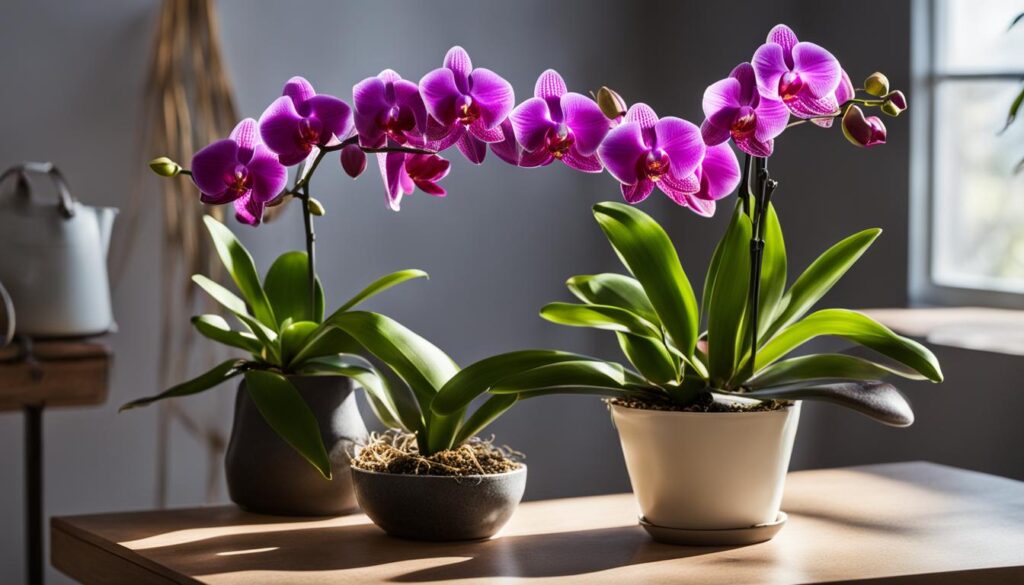
Orchid Care Outdoors
If you’re looking to give your orchids a breath of fresh air and some time outdoors, it’s important to know how to care for them in an outdoor setting. Taking your orchids outside for the summer can be a great way to provide them with a change of scenery and optimal growing conditions.
When placing your orchids outside, it’s crucial to find partially shaded areas that offer protection from direct sunlight, strong winds, and harsh weather conditions. Orchids prefer a balance of light and shade, so positioning them in areas where they can receive filtered sunlight is ideal.
To create a more favorable environment for your outdoor orchids, consider grouping them with other outdoor plants. This can help increase humidity levels and create a microclimate that mimics their natural habitat. Orchids thrive in humid conditions, so the presence of other plants can help create a more humid atmosphere.
Outdoor orchids still require regular watering and fertilization. Monitor the moisture level of the growing mix and water accordingly, ensuring that the roots are not sitting in waterlogged conditions. Fertilize as recommended, taking into account the specific needs of your orchid species.
Finally, if you’re planning to go on vacation or be away from home for an extended period, make arrangements for someone to care for your orchids. They will need regular watering and attention while you’re away to ensure their health and well-being.
How to Prune Orchids
Pruning orchids is an important part of their care. When done correctly, pruning can promote new growth and stimulate future blooming. It’s essential to understand the best time and techniques for pruning orchids to ensure their health and vitality.
When to prune orchids:
- After the orchid has finished blooming
- When new leaves are forming
Pruning techniques:
- Cutting back the flower spike
- Leaving the spike intact for potential re-blooming
- Cutting the spike back to 1/2-inch above the leaves to conserve energy
Pruning not only helps maintain the orchid’s shape and size but also allows it to redirect energy towards new growth. By trimming the flower spike, the orchid can conserve energy and focus on producing healthy leaves and roots.
Pruning Tips:
- Use clean and sterilized cutting tools to prevent the spread of diseases and pests.
- Apply a small amount of cinnamon on the cut surface to prevent fungal infections.
- Continue regular care for pruned orchids, including watering and fertilization.
- Observe the orchid for signs of new growth and adjust care accordingly.
Remember, each orchid species may have specific pruning requirements, so it’s essential to research and understand your orchid’s unique needs. By learning how to prune orchids correctly, you can help your plants thrive and ensure years of beautiful blooms.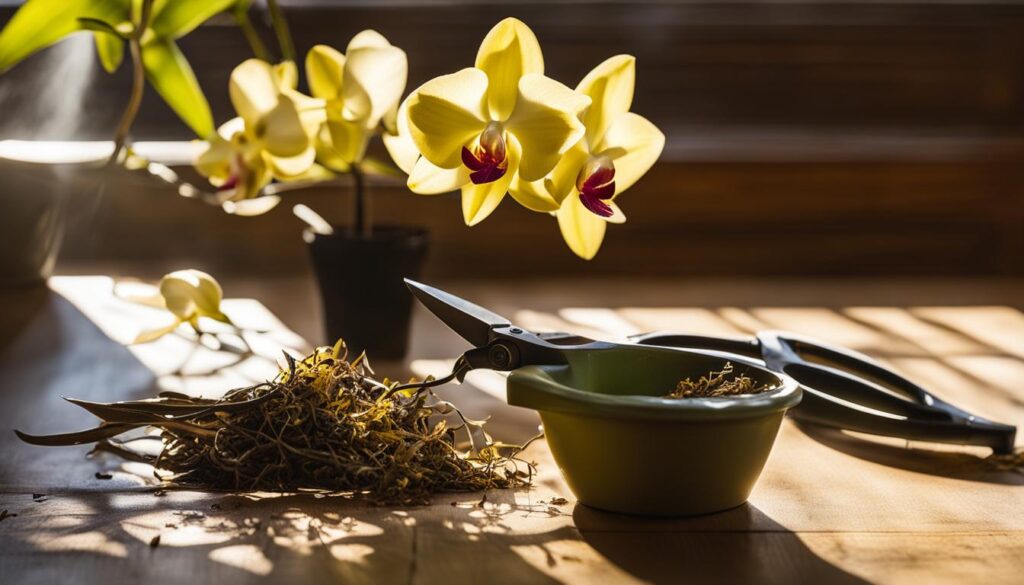
Tips for Pruning Orchids:
“Pruning orchids helps redirect energy towards new growth and stimulates future blooming. Understanding the right time and techniques for pruning is crucial for maintaining orchid health.” – Orchid Enthusiast
Orchid Care During Travel
When you’re out traveling, it’s important to make proper arrangements for the care of your orchids. If you have someone you trust, you can ask them to check on and care for your orchids while you’re away. However, if you don’t have anyone available, there are still measures you can take to ensure your orchids stay healthy in your absence.
An effective method to care for orchids when traveling is to place them in a bathtub on risers. Fill the bathtub with water below the pot bottoms to increase humidity and extend the time between watering. This helps create a microclimate that mimics the orchids’ natural habitat, providing the moisture they need to thrive.
Additionally, it’s beneficial to provide fresh air circulation for your orchids. You can achieve this by opening windows or using a fan set on a low speed. This will help prevent stagnant air and maintain a healthy environment for your plants.
While you’re away, it’s important to regularly inspect your orchids for any signs of pests or diseases. Catching and addressing any issues early will help prevent them from becoming severe and causing long-term damage to your plants.
| Tip | Description |
|---|---|
| Arrange for Caretaker | If possible, have someone you trust check on and care for your orchids while you’re away. |
| Use Bathtub Method | Place your orchids in a bathtub on risers, with water filled below the pot bottoms, to increase humidity and extend watering intervals. |
| Provide Fresh Air | Open windows or use a fan set on a low speed to maintain proper air circulation. |
| Regularly Inspect for Pests and Diseases | Check your orchids periodically for any signs of pests or diseases and address them promptly. |
Taking these steps will help ensure that your orchids receive the care they need when you’re away so that you can return to thriving, beautiful plants.
In the next section, we’ll explore some common mistakes to avoid when caring for your orchids.
Orchid Care Mistakes to Avoid
When it comes to caring for orchids, there are some common mistakes that can hinder their health and blooming potential. By avoiding these orchid care faux pas, you can ensure your orchids stay vibrant and beautiful. Let’s take a look at some of the most common orchid care mistakes and what you should and shouldn’t do to keep your orchids thriving.
Overwatering
One of the biggest mistakes orchid owners make is overwatering their plants. Orchids need a delicate balance of hydration, and too much water can lead to root rot and other issues. It is important to water your orchid only when the potting mix feels dry to the touch, and allow any excess water to drain away. Remember: less is more when it comes to watering orchids.
Improper Lighting
Another common mistake is placing orchids in improper lighting conditions. Orchids need bright, indirect light to thrive. Placing them in direct sunlight can scorch their leaves, while insufficient light can lead to poor growth and lack of blooming. Position your orchids near a window with filtered light or provide artificial lighting that mimics natural sunlight.
Incorrect Potting Mix and Containers
The potting mix and container you choose for your orchids play a crucial role in their overall health. Using the wrong potting mix or container can impede drainage, leading to root issues. Make sure to use a well-draining orchid potting mix that allows air circulation around the roots. Choose containers with ample drainage holes to prevent waterlogging.
Neglecting Regular Fertilization
Regular fertilization is essential for the health and blooming of orchids. However, many orchid owners forget to fertilize or do so infrequently. Orchids have specific nutrient requirements that can only be met through regular fertilization with orchid-specific fertilizers. Follow the recommended fertilization schedule and dilution rates for optimal results.
Extreme Temperature Changes
Subjecting orchids to extreme temperature changes can cause stress and damage to the plants. Avoid placing orchids near heating vents, cold drafts, or in areas with fluctuating temperatures. Orchids prefer stable temperatures between 60 and 80 degrees Fahrenheit. Keep them away from sudden temperature drops or hot air vents.
“Orchids need a delicate balance of hydration, and too much water can lead to root rot and other issues.”
Avoiding these common orchid care mistakes can help ensure that your orchids thrive and reward you with vibrant blooms. By providing the right amount of water, placing them in proper lighting conditions, using the correct potting mix and containers, regularly fertilizing, and avoiding extreme temperature changes, you can enjoy healthy and beautiful orchids in your home.
| Common Orchid Care Mistakes | Orchid Care Dos | Orchid Care Don’ts |
|---|---|---|
| Overwatering | Water orchids only when the potting mix feels dry to the touch. | Avoid watering orchids too frequently or allowing them to sit in standing water. |
| Improper Lighting | Place orchids in bright, indirect light near a window or provide artificial lighting. | Avoid placing orchids in direct sunlight or in dark, low-light areas. |
| Incorrect Potting Mix and Containers | Use a well-draining orchid potting mix and containers with ample drainage holes. | Avoid using regular potting soil or containers without proper drainage. |
| Neglecting Regular Fertilization | Regularly fertilize orchids with orchid-specific fertilizers following the recommended schedule. | Avoid forgetting or infrequently fertilizing orchids. |
| Extreme Temperature Changes | Keep orchids in stable temperatures between 60 and 80 degrees Fahrenheit. | Avoid subjecting orchids to sudden temperature drops or placing them near heating vents or cold drafts. |

By recognizing and avoiding these common orchid care mistakes, you can provide the optimal conditions for your orchids to thrive and display their stunning blooms. Remember to follow proper care instructions and stay attuned to the specific needs of your orchid species for best results.
Orchid Care for Beginners
Getting started with orchid care can seem overwhelming, but with the right guidance, it can be both enjoyable and rewarding. If you’re new to caring for orchids, we recommend starting with a beginner-friendly species like the moth orchid, also known as Phalaenopsis.
Here are some easy orchid care tips to help you get started:
- Proper Watering: Orchids should be watered thoroughly but not excessively. Wait until the potting mix is dry to the touch before watering. Avoid allowing the roots to sit in standing water, as this can lead to root rot.
- Good Light: Position your orchid in a location that receives bright, indirect light. North or east-facing windowsills are usually ideal. If you notice that the leaves are turning yellow or developing brown spots, it may be getting too much direct sunlight.
- Regular Fertilization: Orchids need regular feeding to thrive. Use a specialized orchid fertilizer and follow the instructions on the label. Fertilize your orchid about once a month during the growing season.
- Appropriate Potting Mix: Orchids require a well-draining potting mix that provides good airflow to the roots. Specialized orchid potting mixes that contain ingredients like bark or sphagnum moss work well.
Familiarize yourself with the specific care requirements of your chosen orchid species. Different orchids may have slightly different preferences when it comes to temperature, humidity, and watering frequency. Consult reliable sources or seek advice from experienced orchid enthusiasts or garden centers for additional guidance.
Remember, orchid care is a journey of learning and experimentation. With patience and observation, you’ll develop a deeper understanding of your orchids’ needs, allowing you to provide the best care possible. Enjoy the process and watch as your orchids flourish and reward you with beautiful blooms.
Orchid Care Tools and Supplies
When it comes to caring for your orchids, having the right tools and supplies is essential for their health and well-being. These items will help you provide the necessary care and create an optimal growing environment for your precious orchids.
Essential Orchid Care Tools
“Having the right tools on hand can make orchid care more convenient and effective.”
Here are some essential tools you should have in your orchid care kit:
- Specialized Orchid Fertilizer: Orchids have specific nutritional needs, and using a specialized orchid fertilizer will ensure they receive the essential nutrients they require to thrive.
- Watering Can or Spray Bottle: Orchids need regular and precise watering, and a watering can or spray bottle with a fine mist nozzle will help you deliver water directly to the roots without disturbing the delicate flowers.
- Pruners or Scissors: Clean pruners or scissors are essential for trimming roots or removing spent flower spikes. This will help maintain the overall health and appearance of your orchids.
- Soft Cloth: A soft cloth is handy for dusting the leaves of your orchids, keeping them clean and allowing them to photosynthesize properly.
Orchid Supplies and Equipment
Here are some supplies and equipment that are necessary for proper orchid care:
- Potting Mix: Orchids require a well-draining potting mix that provides good air circulation to their roots. A mix of bark, perlite, and plant-dried fibers is commonly used for this purpose.
- Orchid Pots: Orchid pots should have generous drainage holes to prevent waterlogging and promote healthy root growth. Clear or white pots are beneficial as they allow you to monitor the health of the roots and allow for photosynthesis.
- Humidity Trays or Gravel Trays: Orchids love humidity, and placing them on humidity trays or gravel trays filled with water can help increase the moisture around them. This is especially useful in dry environments.
Having these essential tools and supplies will make it easier for you to care for your orchids and provide them with the optimal growing conditions they need to flourish.
| Tool/Supply | Description |
|---|---|
| Specialized Orchid Fertilizer | A high-quality fertilizer specifically formulated for orchids. Provides essential nutrients for healthy growth and blooming. |
| Watering Can or Spray Bottle | A watering can or spray bottle with a fine mist nozzle for precise and gentle watering, avoiding waterlogging the roots. |
| Pruners or Scissors | Clean and sharp pruners or scissors for trimming roots and removing spent flower spikes, promoting overall plant health. |
| Soft Cloth | A soft cloth for gently dusting the leaves of orchids, allowing them to absorb maximum sunlight for photosynthesis. |
| Potting Mix | A well-draining mix of bark, perlite, and plant-dried fibers to provide good air circulation and drainage for orchid roots. |
| Orchid Pots | Pots with generous drainage holes to prevent waterlogging and promote healthy root growth. Clear or white pots allow visibility of root health. |
| Humidity Trays or Gravel Trays | Trays filled with water to increase humidity around orchids, especially beneficial in dry environments. |
With these tools and supplies at your disposal, you’ll be well-equipped to provide the best care for your orchids and enjoy their stunning beauty for years to come.

Conclusion
Orchid care can be a truly rewarding and enjoyable experience for all orchid enthusiasts. By understanding the specific needs of your orchids and implementing the right practices, you can ensure their health and stunning blooming. Key elements of successful orchid care include proper watering, positioning in optimal light, regular fertilization, and using the right potting mixes.
Avoiding common care mistakes, such as overwatering or subjecting your orchids to extreme temperature changes, is crucial in maintaining their well-being. Consistency in care is also essential for orchids to thrive and provide vibrant blooms. Whether you are caring for your orchids indoors or outdoors, whether you are a beginner or an experienced grower, following these essential orchid care tips can lead to success.
Remember to observe and adjust the care routine based on the specific needs and characteristics of your orchids. Patience and attentive observation are key factors in providing the best care for your orchids. With dedication and a little bit of knowledge, you can create a nurturing environment for your orchids, and be rewarded with their stunning beauty year after year. When it comes to orchid care, applying the ultimate boston fern care tips can lead to healthy blooms. Just like Boston ferns, orchids thrive in a humid environment and prefer indirect sunlight. Additionally, regular misting and proper watering techniques can promote healthy growth and vibrant blooms for your orchids. Some basic tips for caring for orchids include regular watering, positioning them in a bright windowsill, weekly feeding with orchid fertilizer, and repotting when the orchid stops blooming. There are over 22,000 species of orchids, but only several dozen species are widely produced and available at local nurseries. The most common orchids found in homes include Phalaenopsis (moth orchids), Dendrobium, Cymbidium (boat orchids), and Cattleya. Orchids prefer warm temperatures between 60 and 80 degrees Fahrenheit and thrive in air that is 50 percent humidity or above. They should be positioned away from drafts, cold spaces, sudden temperature drops, and hot air vents. Orchids should be watered once a week by running water over the roots and potting mix, allowing the water to drain thoroughly. Orchids prefer growing in a special potting mix made of components such as bark, perlite, and plant-dried fibers to ensure good drainage and air circulation. Orchids should be fertilized regularly during the warmer months with a water-soluble orchid fertilizer. To enhance and extend orchid blooms, it is important to maintain temperatures below 85 degrees Fahrenheit, follow a consistent watering schedule, avoid sudden location changes, and provide extra support for larger orchids when the stems turn into blooms. Orchids should be repotted every 1 to 2 years in a container that is slightly larger than the existing pot when the roots outgrow the current container or the potting mix breaks down. Some common orchid care mistakes to avoid include overwatering, placing orchids in improper lighting conditions, using incorrect potting mixes or containers, neglecting regular fertilization, and subjecting orchids to extreme temperature changes. Some essential tools and supplies for orchid care include specialized orchid fertilizer, watering can or spray bottle, potting mix, orchid pots with generous drainage holes, clean pruners or scissors for trimming roots or spikes, soft cloth for dusting leaves, and humidity trays or gravel trays for increased moisture. Beginners to orchid care can start by choosing an orchid species that is easier to care for, such as the moth orchid (Phalaenopsis). They should familiarize themselves with basic care requirements, consult reliable sources or experts for additional guidance, and understand the specific needs of their chosen orchid species.How Can I Apply Boston Fern Care Tips to Orchid Care for Healthy Blooms?
FAQ
What are some basic tips for caring for orchids?
How many species of orchids are there?
What are the most common types of orchids found in homes?
What are the ideal conditions for growing orchids?
How often should orchids be watered?
What kind of potting mix should be used for orchids?
How often should orchids be fertilized?
How can orchid blooms be enhanced and extended?
When should orchids be repotted?
What are some common orchid care mistakes to avoid?
What are some essential tools and supplies for orchid care?
Any tips for beginners to orchid care?
- About the Author
- Latest Posts
Introducing Ron, the home decor aficionado at ByRetreat, whose passion for creating beautiful and inviting spaces is at the heart of his work. With his deep knowledge of home decor and his innate sense of style, Ron brings a wealth of expertise and a keen eye for detail to the ByRetreat team.
Ron’s love for home decor goes beyond aesthetics; he understands that our surroundings play a significant role in our overall well-being and productivity. With this in mind, Ron is dedicated to transforming remote workspaces into havens of comfort, functionality, and beauty.
Plants
Ideal Hydrangea Spots: Best Place to Plant Hydrangeas
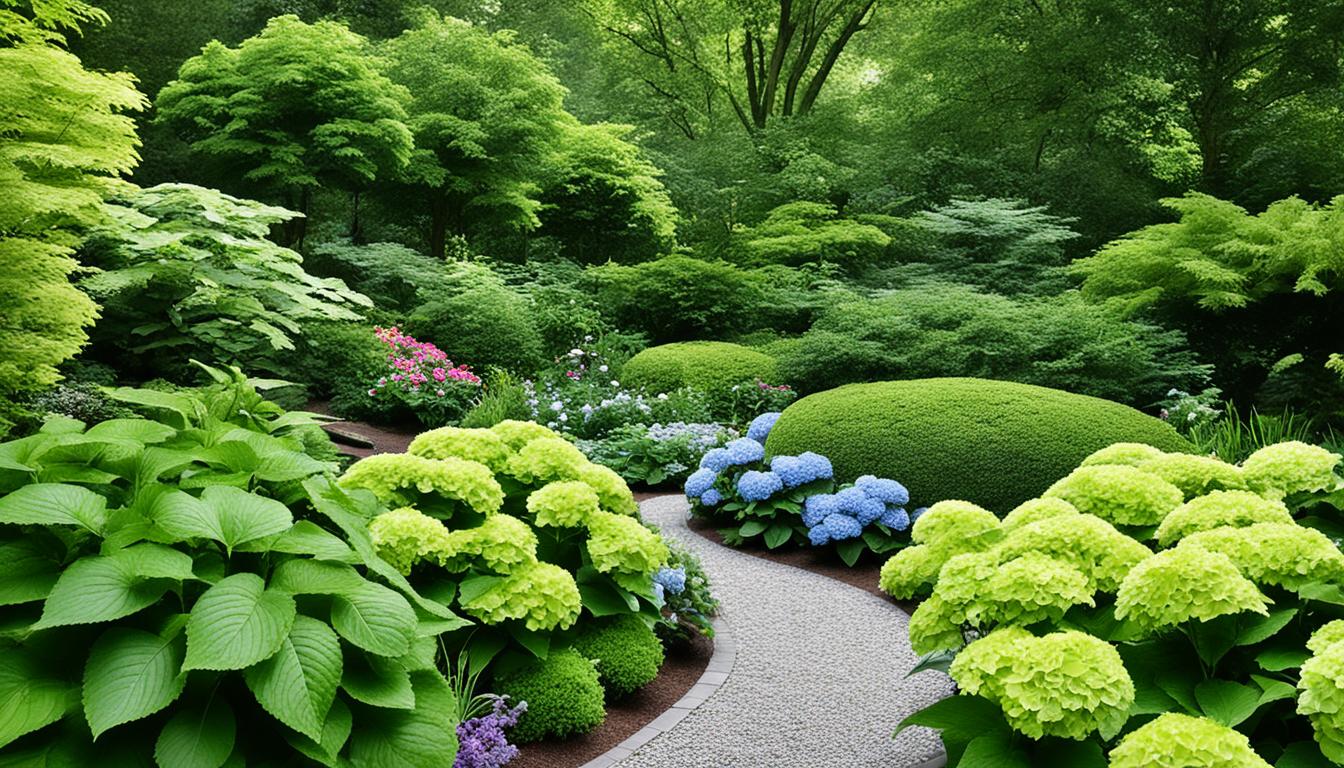
Did you know that the location where you plant your hydrangeas can have a significant impact on their growth and vibrancy? Finding the best place to plant hydrangeas is essential for optimal growth and to ensure that you get the most beautiful blooms.
In this guide, we will explore the different factors to consider when selecting the ideal spot for your hydrangeas. Whether you have a sunny garden or a shady corner, we’ll help you choose the right hydrangea varieties to thrive in various sun and shade conditions. By understanding their sunlight preferences and caring for them properly, you can enjoy vibrant and healthy hydrangea blooms year after year.
Key Takeaways:
- Choosing the right location is crucial for the growth and vibrancy of hydrangeas.
- Hydrangeas can thrive in different sunlight conditions, from full sun to partial shade.
- Consider the specific sunlight needs of different hydrangea varieties for optimal results.
- Proper care, including pruning, fertilizing, and watering, is essential for healthy blooms.
- By following our planting guide and care tips, you can transform your garden with stunning hydrangea displays.
Hydrangeas for Part Shade: Give Us Some Sunblock Please
When it comes to creating the perfect environment for hydrangeas, finding the right balance of sun and shade is key. While some hydrangea varieties thrive in full sun, others prefer a location with partial shade, where they can benefit from the morning sun and enjoy relief from the scorching afternoon rays. These hydrangeas are like beachgoers who know the importance of sunblock, seeking a little shade to protect themselves from the intense heat.
In the family of hydrangeas, there are several popular cultivars that are well-suited for part shade conditions. These varieties have the ability to produce stunning blooms when provided with a combination of filtered light and a few hours of full sun. Among them are the beloved Endless Summer® Hydrangea series, which includes BloomStruck®, Endless Summer®, Blushing Bride®, and Twist-n-Shout®.
Another great choice for morning sun and afternoon shade is the Annabelle Hydrangea, which is known for its spectacular large white flowers. And let’s not forget the many bigleaf hydrangea cultivars that can handle part shade and reward you with their vibrant blossoms.
Here are a few remarkable hydrangea varieties that thrive in part shade:
| Hydrangea Variety | Light Requirements |
|---|---|
| Endless Summer® series (BloomStruck®, Endless Summer®, Blushing Bride®, Twist-n-Shout®) | Morning sun, afternoon shade |
| Annabelle Hydrangea | Morning sun, afternoon shade |
| Bigleaf hydrangea cultivars | Morning sun, afternoon shade |
These hydrangeas have adapted to thrive in part shade by enjoying the gentle morning sun and being sheltered from the intense afternoon heat. This combination of light conditions allows them to produce their enchanting blooms and add a touch of elegance to any garden or landscape.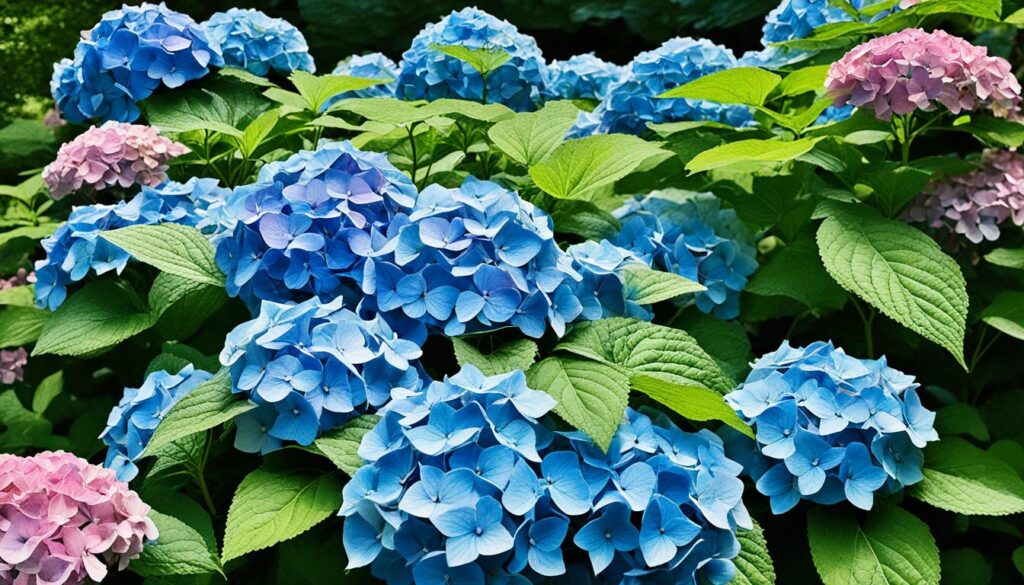
So, if you have a garden or yard with a mix of sunlight and shade, don’t worry! There are plenty of beautiful hydrangeas that will thrive in this environment. Just give them some sunblock (in the form of morning sun) and watch as their blooms light up your space with their breathtaking beauty.
Hydrangeas for Full Sun: We Like It Sunny
While most hydrangeas prefer some shade, there are certain varieties that can thrive in full sun. If your garden gets plenty of sunlight, don’t worry! There are hydrangeas that will flourish in these conditions and reward you with beautiful blooms.
Panicle Hydrangeas
Panicle hydrangeas, known for their cone-shaped flower clusters, are excellent choices for full sun exposure. They can tolerate the direct heat and intense sunlight, making them perfect for sunny spots in your garden. Some popular panicle hydrangeas include:
- Fire Light®
- Limelight
- Pinky Winky®
- Strawberry Sundae®
- Vanilla Strawberry®
Dwarf Varieties
If you have limited space or prefer compact hydrangeas, consider the Let’s Dance® and Cityline® series. These dwarf varieties are perfect for both full sun and part sun environments. They offer the beauty of hydrangeas in a smaller package without compromising on vibrant blooms.
Smooth Hydrangeas
Smooth hydrangeas are another type that can handle full or part sun conditions. These varieties are known for their large rounded flower heads and are a great choice for a sunny garden. Consider the following smooth hydrangeas:
- Incrediball®
- Invincibelle® Ruby
With these hydrangeas, you can enjoy the beauty and charm of these flowering plants even in full sun areas. Just make sure to provide them with proper care and maintenance, including regular watering and occasional fertilization.
Overall, including hydrangeas that thrive in full sun can add a splash of color and vibrancy to your garden. Whether you choose panicle hydrangeas, dwarf varieties, or smooth hydrangeas, these sun-loving beauties will brighten up any sunny corner of your outdoor space.
Growing Hydrangeas in Different Sun and Shade Conditions
When it comes to growing hydrangeas, understanding their sunlight requirements is essential for their success. While many hydrangea varieties thrive in partial shade, oakleaf hydrangeas are known for their adaptability to different sun and shade conditions.
In the northern parts of the United States, oakleaf hydrangeas can tolerate full sun. However, in warmer and southern climates, they prefer some afternoon shade to protect them from excessive heat and sun exposure. This makes them an excellent choice for those looking to plant hydrangeas in regions with varying temperature and sunlight conditions.
What makes oakleaf hydrangeas unique is their ability to also tolerate full shade. This makes them ideal for areas of the garden that receive little to no direct sunlight. Whether it’s a densely shaded corner or underneath taller trees, oakleaf hydrangeas can thrive and add beauty to areas that are typically challenging for other hydrangea varieties.
It’s important to note that while oakleaf hydrangeas are the most adaptable, other hydrangea varieties have specific sunlight needs. When selecting the location for planting, it’s crucial to consider the specific requirements of each hydrangea type to ensure optimal growth and vigor.
By carefully assessing the sunlight conditions in your garden and selecting the appropriate hydrangea varieties, you can create a diverse and captivating display of hydrangeas that thrive in different sun and shade conditions.
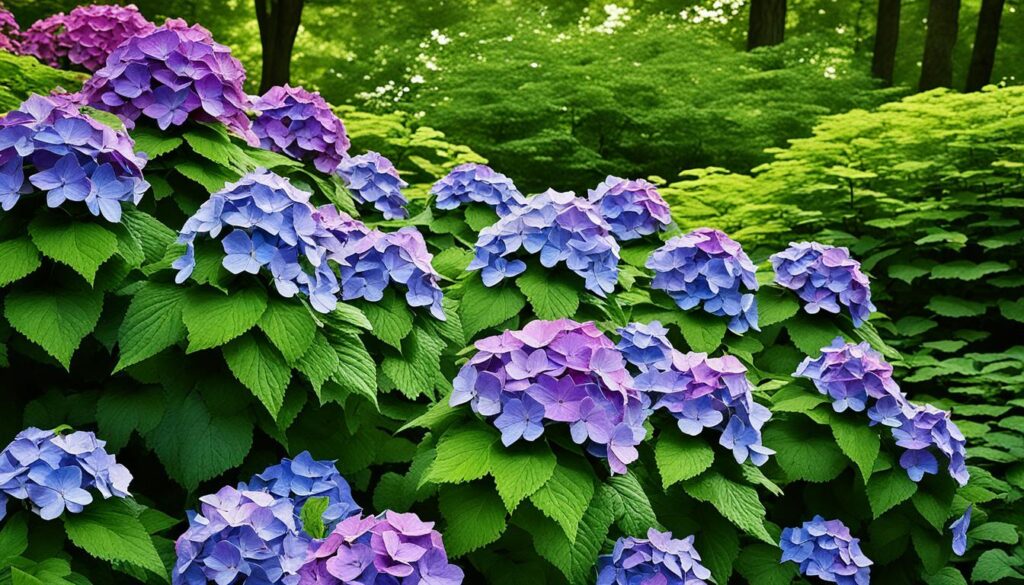
Pruning and Caring for Hydrangeas
Proper pruning and care are essential for the health and vitality of hydrangeas. By implementing appropriate pruning techniques and providing the necessary care, gardeners can ensure the longevity and abundant blooming of their hydrangea plants. Here are some important tips to consider:
Understanding Pruning Methods
When pruning hydrangeas, it’s crucial to understand whether the plant blooms on old wood or new wood. This knowledge will help gardeners avoid accidentally cutting off next season’s flowers.
Tip: Prune hydrangeas that bloom on old wood immediately after flowering. This allows for new growth and development of flower buds for next year. On the other hand, hydrangeas that bloom on new wood can be pruned during late winter or early spring before new growth begins.
Optimal Soil Conditions
Hydrangeas thrive in well-drained soil that is rich in organic matter. A mixture of compost and native soil is ideal for providing the necessary nutrients and moisture retention.
Fertilizing for Healthy Blooms
To promote healthy blooming, it’s recommended to fertilize hydrangeas with a slow-release fertilizer that is high in phosphorus. Phosphorus is essential for promoting flower production and overall plant vitality.
Preventing Leaf Scorch
Hydrangeas are susceptible to leaf scorch, especially during hot and dry periods. To prevent leaf scorch, it’s important to provide hydrangeas with extra water and ensure they have adequate moisture in the soil.

Summary of Pruning and Care Tips
| Pruning Method | Soil Conditions | Fertilizing | Preventing Leaf Scorch |
|---|---|---|---|
| Prune hydrangeas that bloom on old wood immediately after flowering | Well-drained soil with organic compost | Use slow-release fertilizer high in phosphorus | Provide extra water during hot and dry periods |
By following these pruning and care tips, hydrangea enthusiasts can enjoy lush, vibrant blooms year after year. With proper maintenance, these stunning plants will continue to beautify gardens and landscapes.
Conclusion
Planting hydrangeas in the best location and providing proper care and maintenance are key to achieving beautiful and vibrant blooms. By selecting the right spot that balances sun and shade, ensuring well-drained soil, and following recommended pruning and watering practices, gardeners can enjoy the full potential of their hydrangea plants. With the right planting and care, hydrangeas can transform any garden into a colorful and inviting space.FAQ
What is the best place to plant hydrangeas?
What are the best types of hydrangeas for morning sun and afternoon shade?
Can hydrangeas grow in full sun?
Which hydrangea varieties are best for full shade?
How should I prune and care for hydrangeas?
Are there any tips for planting and caring for hydrangeas?
- About the Author
- Latest Posts
Meet Katherine, the creative enthusiast at ByRetreat who infuses her boundless passion for design into every remote workspace she crafts. With an innate sense of creativity and an eye for unconventional beauty, Katherine brings a unique and inspiring perspective to the team.
Katherine’s love for design is infectious, and her ability to think outside the box sets her apart. She believes that true artistry lies in embracing a variety of styles and mixing them harmoniously to create captivating spaces. By combining different textures, colors, and patterns, Katherine weaves a tapestry of creativity that breathes life into each remote workspace.
Plants
Grow Zucchini Successfully: Best Way & Tips

Did you know that zucchini plants are susceptible to squash vine borers, a pest that can quickly kill the plants by cutting off the flow of water? The impact of these destructive borers can be devastating to your zucchini harvest. However, by following the best practices and tips for growing zucchini, you can ensure successful cultivation and enjoy a bountiful harvest.
Whether you are a seasoned gardener or a novice looking to try your hand at gardening, this article will provide you with valuable insights on the best way to grow zucchini and tips for successful cultivation. From avoiding squash vine borers to proper planting techniques, soil requirements, spacing, and pollination, we will cover everything you need to know to grow zucchini successfully.
Key Takeaways:
- Delay planting zucchini until mid-July or use row covers to prevent squash vine borers
- Start zucchini from seeds or seedlings and choose the right time to plant
- Provide well-draining soil enriched with organic material for optimal growth
- Space zucchini plants at least 3-4 feet apart and consider trellising for better air circulation
- Ensure proper pollination for optimal fruit production and harvest zucchini at any size
Planting and Germination
Zucchini, a popular summer squash variety, can be easily grown from seeds or seedlings. While starting zucchini indoors is an option, direct sowing in the ground is the preferred and most common method of planting zucchini seeds. Here’s a step-by-step guide to planting zucchini seeds and ensuring successful germination:
1. Prepare the Soil
Before starting zucchini indoors or sowing the seeds outside, it’s crucial to have well-prepared soil. Ensure the soil is loose, rich in organic matter, and drains well. Incorporating compost or aged manure can greatly improve the soil’s fertility. Measure the soil temperature and wait until it consistently reaches above 55 degrees Fahrenheit for successful germination.
2. Planting Zucchini Seeds
When the soil is ready, plant the zucchini seeds about an inch deep into the soil. Space the seeds at least 3 feet apart to allow ample room for growth. Lightly mist the top of the soil with water to ensure proper moisture levels for the germination of zucchini. Take care not to overwater the seeds, as it can lead to rotting.
Pro Tip: For those who prefer starting zucchini indoors, plant the seeds in peat pots or biodegradable seed starting trays about 2-3 weeks before the last expected frost. Transplant the seedlings outdoors once the soil temperature is suitable.
3. Germination and Thinning
The germination period of zucchini seeds typically ranges from 5 to 10 days. During this time, it’s important to keep the soil consistently moist but not waterlogged. Once the seedlings reach a height of around 3 inches and develop 2 sets of true leaves, it’s time to thin them out. Starting zucchini indoors often leads to more seedlings, so removing the weaker ones will allow the strongest ones to flourish.
4. Timing is Key
For optimal growth, it’s crucial to plant zucchini at the right time. Zucchini thrives in warm soil, so direct sowing should take place in the second half of May when the risk of frost has passed and the soil has warmed up. This timing ensures that the young seedlings will not succumb to cold temperatures.
“Direct sowing zucchini seeds is the most practical and successful method for home gardeners. The plants quickly establish themselves and produce abundant healthy foliage and fruit.” – Gardening Expert, Jessica Washington
By following these planting zucchini seeds and germination guidelines, you can give your zucchini plants a head start in their growth journey. Whether you choose to start the seeds indoors or directly sow them in the ground, with proper care and attention, you’ll soon be rewarded with healthy zucchini plants ready to produce an abundance of delicious squash.
| Benefits of Direct Sowing Zucchini Seeds | Benefits of Starting Zucchini Indoors |
|---|---|
| 1. Simplifies the planting process | 1. Provides an earlier start to the growing season |
| 2. Minimizes transplant shock | 2. Offers more control over seedling development |
| 3. Allows seeds to germinate and grow in their natural environment | 3. Enables better protection against adverse weather conditions |
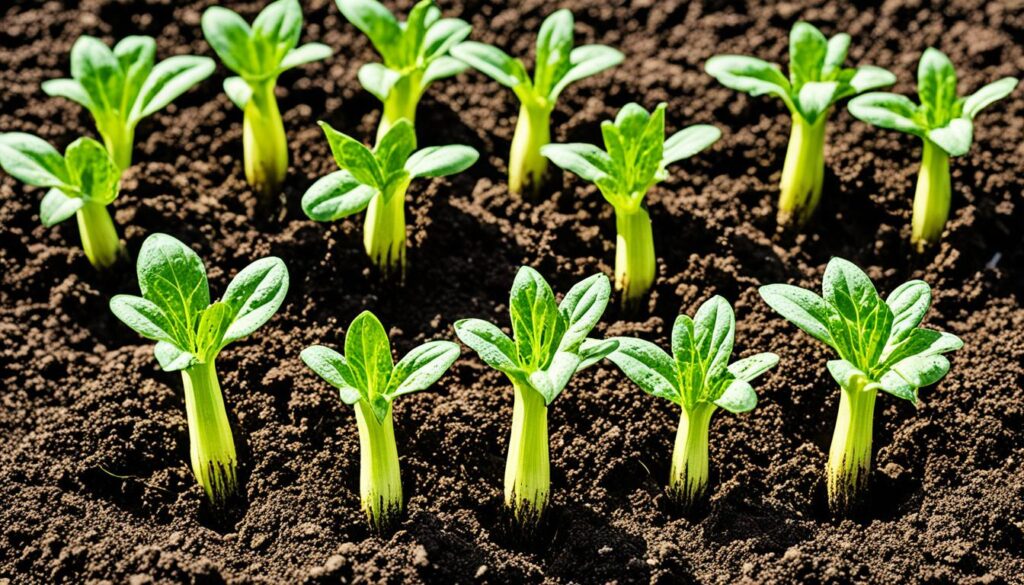
Soil and Location Requirements
Zucchini plants require specific soil and an ideal location to thrive and produce a bountiful harvest. Providing the right conditions for your zucchinis will ensure their health and productivity.
Choosing the Best Soil
Zucchini plants prefer organically rich, fertile, and well-draining soil. When planting in raised beds or containers, it is essential to select a well-draining potting soil. To enhance the soil’s fertility, add organic material or compost at the time of planting. This will help create a nutrient-rich environment for the zucchini plants to thrive.
If you are planting zucchinis directly in the ground, it is crucial to amend the soil with rich organic material or compost. This will improve the soil’s texture and provide the necessary nutrients for the plants to grow strong and healthy. Additionally, good drainage is essential for zucchini plants, as they prefer moist but not waterlogged conditions.
Choosing the Ideal Location
When selecting a location for your zucchini plants, it is important to consider their sunlight requirements. Zucchinis thrive in areas that receive full sun for at least 6-8 hours a day. Choose an area in your garden that is not shaded by buildings or trees, as this can hinder their growth and development.
Furthermore, it is important to note that zucchinis should not be planted in soil where other cucurbits (such as pumpkins or cucumbers) were grown in the past 1-2 years. This practice helps prevent the spread of diseases and pests that may affect the zucchini plants.
By providing the right soil conditions and selecting an ideal location with ample sunlight, you will create an optimal environment for your zucchini plants to flourish and produce an abundant crop.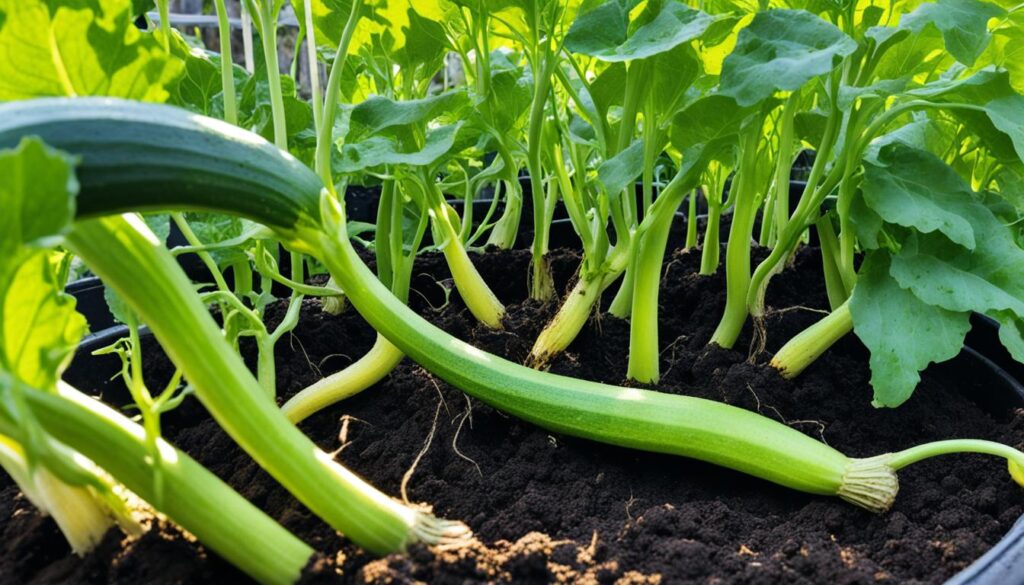
“Zucchini plants prefer organically rich, fertile, and well-draining soil. Provide the right conditions to help your zucchini plants thrive and produce a bountiful harvest.”
Spacing and Trellising
Proper spacing and trellising techniques are essential for the successful growth and development of zucchini plants.
Spacing Zucchini Plants
When it comes to zucchini plant spacing, giving enough room for each plant is crucial for optimal growth. It is recommended to space zucchini plants at least 3-4 feet apart, whether planting them in hills or rows.
For planting in hills, a general guideline is to plant 3 zucchinis per hill in a triangle pattern. Ensure the hills are also spaced 3-4 feet apart to provide enough space for the plants to receive nutrients and expand their root systems.
If growing zucchinis in containers, create a mound in the center of the container and plant three zucchinis around it. This arrangement allows for adequate airflow and efficient use of space while providing the plants with the necessary growing area.
Trellising Zucchini
Another option for maximizing space and aiding in pest management is trellising zucchini plants. By training them to grow vertically along a trellis or stakes, you can create a visually appealing and space-saving garden.
When trellising zucchini, ensure that the trellis or stakes are sturdy enough to support the weight of the plants and their fruit. As the zucchinis grow, gently guide the vines and tendrils toward the trellis, securing them with twist ties or plant clips.
The benefits of trellising zucchini include improved air circulation, which helps prevent disease, easier harvesting, and reduced pest damage since the plants are elevated off the ground.
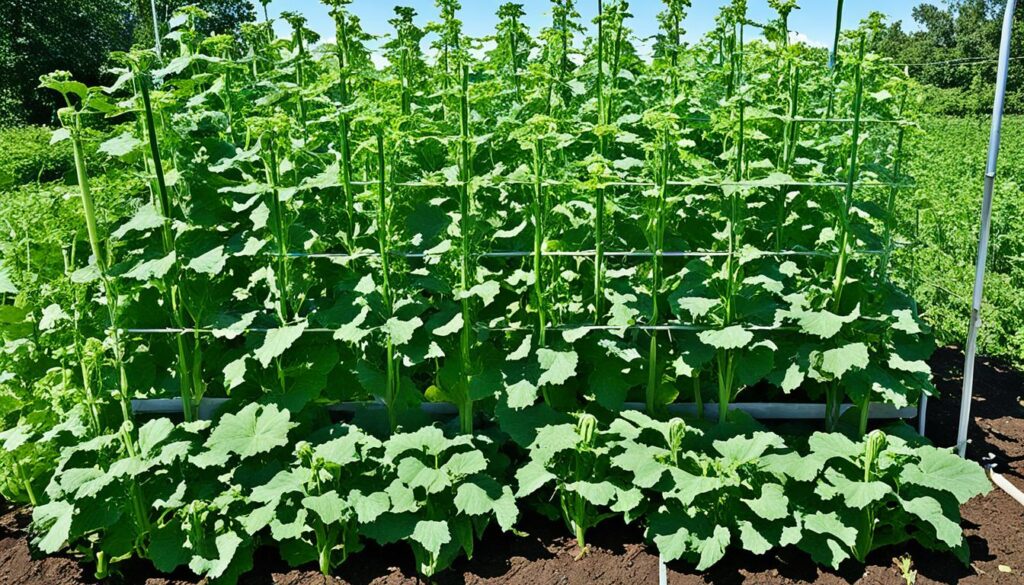
Implementing proper spacing and trellising techniques ultimately promotes healthier zucchini plants, increased productivity, and efficient use of garden space.
Pollination and Fruit Production
Zucchini plants rely on pollination for fruit production. These plants have separate male and female flowers, and the transfer of pollen from the male to the female flowers is crucial for the development of zucchini fruits. To ensure successful pollination, it’s important to understand how pollinators play a role in this process. 
Pollinators such as bees, butterflies, and other insects are attracted to the bright yellow flowers of zucchini plants. To maximize their presence in your garden, consider planting companion flowers like borage, catmint, dill, or dahlias nearby. These flowers will help attract pollinators, increasing the chances of successful pollination.
In some cases, there may be a lack of natural pollination due to factors such as weather conditions or a limited number of pollinators in the area. In such situations, manual pollination can be done to ensure fruit production. This process involves using a small brush or cotton swab to transfer pollen from the male flowers to the female flowers. By gently brushing the inside of the male flower and then transferring the pollen to the stigma of the female flower, you can help facilitate pollination.
Tip: To identify male and female flowers, look for the presence of a small zucchini-shaped swelling at the base of the female flower. Male flowers, on the other hand, do not have this swelling.
Proper pollination is essential for optimal fruit development. It ensures that the female flowers receive the necessary pollen for fertilization, leading to the formation of healthy zucchini fruits. Be sure to monitor the progress of your zucchini plants and check for signs of fruits developing from the female flowers.
When it comes to harvesting zucchini, you can do so at any size. However, larger zucchinis may have more developed seeds and a denser texture, which might not be desirable for certain recipes. In such cases, it is recommended to remove the seeds before consumption. This can be done by slicing the zucchini lengthwise and scooping out the seeds with a spoon.
Conclusion
Successful zucchini cultivation requires attention to several key factors, including avoiding squash vine borers, following proper planting techniques, providing the right soil and location, spacing plants correctly, and ensuring proper pollination. By implementing these tips and techniques, gardeners can enjoy a bountiful harvest of zucchinis that can be incorporated into a wide range of dishes.
The best way to grow zucchini is to start by carefully timing the planting, ensuring that soil temperatures are consistently above 55 degrees Fahrenheit. This warm soil temperature provides an ideal environment for germination and growth. Additionally, choosing a well-lit area with full sun for at least 6 hours a day will help zucchinis thrive.
When it comes to soil and location requirements, zucchini plants prefer organically rich and well-draining soil. Amend the soil with compost or rich organic material to promote healthy growth. Adequate spacing is essential for proper plant development, with a recommended distance of 3-4 feet between plants. Trellising zucchini plants can also save space and improve airflow.
Finally, ensuring proper pollination is crucial for maximizing fruit production. Planting companion flowers near zucchinis can attract beneficial pollinators, and manual pollination can be done to supplement natural pollination. Harvesting can be done at any size, but larger zucchinis may require seed removal before consumption.FAQ
When is the best time to plant zucchini?
How can I prevent squash vine borers from killing my zucchini plants?
What type of soil do zucchini plants prefer?
How should I space my zucchini plants?
Do zucchini plants require manual pollination?
Can I grow zucchini vertically?
- About the Author
- Latest Posts
Meet Katherine, the creative enthusiast at ByRetreat who infuses her boundless passion for design into every remote workspace she crafts. With an innate sense of creativity and an eye for unconventional beauty, Katherine brings a unique and inspiring perspective to the team.
Katherine’s love for design is infectious, and her ability to think outside the box sets her apart. She believes that true artistry lies in embracing a variety of styles and mixing them harmoniously to create captivating spaces. By combining different textures, colors, and patterns, Katherine weaves a tapestry of creativity that breathes life into each remote workspace.
Plants
Best Conditions for Ginger Root Growth Explained
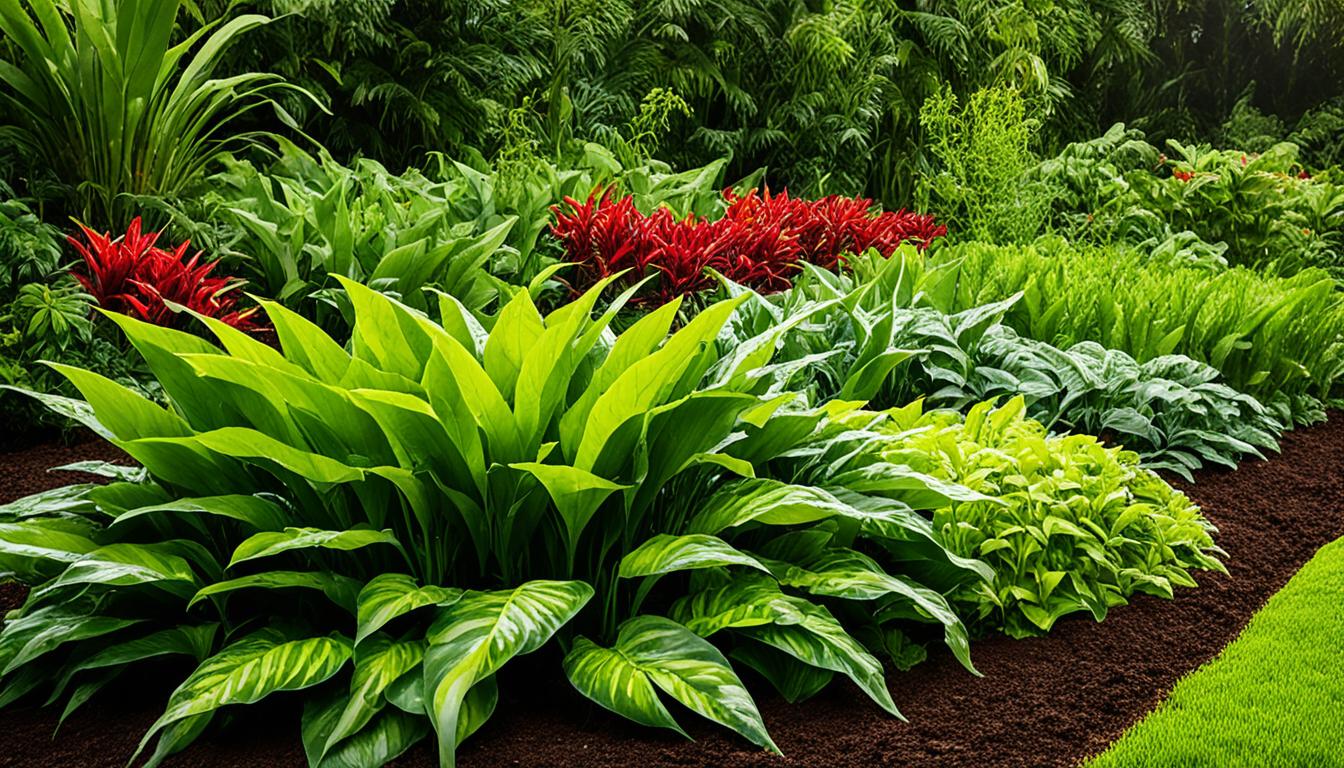
Ginger, known for its unique flavor and medicinal properties, is a versatile root used in everything from cooking to herbal remedies. But did you know that the success of ginger cultivation depends heavily on the conditions in which it is grown? Creating the best conditions for ginger root growth is essential to yield a bountiful harvest and vibrant plants.
From temperature to soil quality and moisture levels, each aspect plays a crucial role in ginger’s growth and well-being. By understanding the optimal conditions, gardeners and enthusiasts can replicate ginger’s tropical habitat and cultivate healthy plants with exceptional flavor and aroma.
In this article, we will explore the optimal conditions necessary for ginger root growth, offering insights and techniques to help you grow ginger successfully. Whether you’re an experienced gardener or a beginner with a green thumb, this guide will provide valuable knowledge to enhance your ginger cultivation.
Key Takeaways:
- Ginger root growth requires specific conditions to thrive.
- Temperature, soil quality, moisture, and shade are essential factors.
- Best practices include using organic matter, maintaining proper drainage, and providing dappled shade.
- Ginger can be grown in containers, hoop houses, or greenhouses.
- Pre-sprouting ginger indoors can maximize the growing season.
Optimal Soil Conditions for Ginger Root Growth
Ginger plants require optimal soil conditions to thrive and produce healthy root growth. By providing the right environment, gardeners can ensure that their ginger plants receive the necessary nutrients and support for robust growth. Here are some essential factors to consider when creating optimal soil conditions for ginger root growth:
- Rich in Organic Matter: Ginger prefers soil that is rich in organic matter, which provides essential nutrients and promotes healthy root development. Adding lots of compost to the ground or using a peat and wood bark-based soilless medium mixed with sand in containers can help create a fertile growing medium.
- Organic Fertilizers and Worm Castings: Supplementing the soil with organic fertilizers and worm castings can further enhance the nutrient content, ensuring that ginger plants have access to the necessary elements for their growth. These natural amendments provide a slow-release source of nutrients, promoting long-term plant health.
- Good Drainage: It is crucial to ensure good drainage in the soil to prevent waterlogging, as standing water can negatively affect ginger growth. To improve drainage, incorporating coarse sand or perlite into the soil can help create a well-draining environment for the roots.
- pH Levels: Maintaining the right pH levels is essential for optimal ginger growth. Ginger plants prefer slightly acidic soil, with pH levels between 5.5 and 6.5. Testing the soil’s pH and making appropriate adjustments using organic soil amendments or sulfur can help create the ideal conditions for ginger plants.
By creating soil conditions that are rich in organic matter, well-draining, and with the right pH levels, gardeners can provide the optimal environment for ginger root growth. The next section will explore the ideal temperature range for ginger plants and the impact it has on their growth and development.
Soil Conditions for Ginger Root Growth
| Soil Condition | Description |
|---|---|
| Rich in organic matter | Ginger prefers soil that is rich in organic matter, such as compost or a peat and wood bark-based soilless medium mixed with sand. |
| Organic fertilizers and worm castings | Adding organic fertilizers and worm castings can provide essential nutrients for ginger plants. |
| Good drainage | Ensuring good drainage in the soil is crucial to prevent waterlogging, which can negatively affect ginger growth. |
| pH levels between 5.5 and 6.5 | Maintaining slightly acidic soil with pH levels between 5.5 and 6.5 is ideal for ginger plants. |

Ideal Temperature Range for Ginger Root Growth
Ginger is a tropical plant that thrives in warm temperatures, making the ideal temperature range a crucial factor for its successful growth. The ideal temperature range for ginger root growth is 70° to 90°F (21° to 32°C). This range provides the optimal conditions for ginger plants to thrive and produce healthy rhizomes.
When growing ginger, it is important to consider the nighttime temperatures as well. It is recommended to plant ginger when nighttime temperatures are consistently above 55°F (13°C). Cooler temperatures can slow down the growth of ginger plants or even cause damage to them, hindering their development.
In regions with colder climates, it may be challenging to maintain these ideal temperatures for ginger growth. However, there are ways to overcome this obstacle and still grow ginger successfully. Growing ginger indoors in a controlled environment, such as a greenhouse or conservatory, can provide the necessary warmth for ginger plants to thrive.

Importance of Moisture for Ginger Root Growth
Ginger is a moisture-loving plant that requires consistent watering to thrive and produce healthy and flavorful roots. Proper moisture management is essential for ginger root growth.
The soil should be kept evenly moist, providing enough water to meet the plant’s needs without overwatering or allowing the soil to dry out completely. Overwatering can lead to waterlogged conditions, which can suffocate the roots and promote the development of root rot. Conversely, letting the soil dry out completely can cause stress to the plant and hinder its growth.
Watering frequency may vary depending on factors such as the climate, humidity levels, and container size. In general, it is advisable to water ginger plants whenever the top inch of soil feels slightly dry. This allows for proper hydration without risking waterlogging.
Proper irrigation techniques and good drainage are crucial for maintaining the ideal moisture levels for ginger root growth. In containers, ensure that there are drainage holes to prevent water from pooling at the bottom. For in-ground planting, selecting a well-draining soil or amending the soil with organic matter can improve moisture balance.
Expert Tip:
When watering ginger plants, it’s important to give them a deep soak, allowing the water to penetrate the root zone. However, avoid overhead watering as it can lead to the development of fungal diseases. Instead, direct the water towards the base of the plant or use a drip irrigation system to ensure precise watering.
By maintaining the right moisture levels through proper watering techniques and good drainage, gardeners can provide the optimal conditions for ginger root growth, ensuring healthy plants and a bountiful harvest.

Moisture Guidelines for Ginger Root Growth
| Moisture Level | Signs | Recommended Action |
|---|---|---|
| Soggy or Waterlogged | Wilting, yellowing leaves; foul odor; root rot | Improve drainage by adding organic matter; reduce watering frequency |
| Too Dry | Wilting, dry soil; slow growth | Increase watering frequency; mulch around plants to retain moisture |
| Evenly Moist | Healthy foliage; steady growth | Continue regular watering; monitor moisture levels |
Benefits of Dappled Shade for Ginger Root Growth
Ginger plants thrive in dappled shade, which provides them with a balanced environment for optimal growth. The benefits of dappled shade include protection from direct sunlight, prevention of soil overheating and excessive drying, and maintenance of suitable moisture levels.
Planting ginger under the shelter of taller crops or using shade cloth can create the perfect conditions for ginger root growth. The dappled shade allows the plants to receive filtered sunlight, which is essential for photosynthesis while reducing the risk of sunburn or heat stress.
“Dappled shade is like a natural sunscreen for ginger plants, shielding them from the harsh rays of the sun and maintaining a cool, comfortable environment.”
By providing dappled shade, you can create an ideal microclimate for ginger root growth. The shade helps regulate soil temperatures, preventing it from becoming too hot and drying out too quickly. This is particularly important for ginger, as it prefers consistently moist soil.
Moreover, dappled shade helps to reduce water evaporation, allowing the roots to stay moist for longer periods. This helps the ginger plants establish a strong root system and absorb essential nutrients from the soil, promoting healthy growth and development.
When setting up dappled shade for your ginger plants, it is important to strike a balance. While providing shade, ensure that there is still enough light penetration for proper photosynthesis. Ginger plants need adequate sunlight to produce energy for growth, but too much direct sunlight can be detrimental.
Consider planting ginger in an area where it receives morning sun and partial afternoon shade. This allows the plants to benefit from the warmth and light of the morning sun while being shielded from the intense heat of the afternoon sun.
To summarize, dappled shade provides numerous benefits for ginger root growth, including protection from direct sunlight, prevention of soil overheating and excessive drying, and maintenance of suitable moisture levels. By implementing dappled shade techniques, you can create an ideal environment for ginger plants to thrive and produce a bountiful harvest.
Pros and Cons of Dappled Shade for Ginger Root Growth
| Benefits of Dappled Shade | Considerations for Dappled Shade |
|---|---|
| Protection from direct sunlight | Ensure there is still enough light for photosynthesis |
| Prevents soil overheating | Find a balance between shade and sunlight |
| Reduces soil drying out | Choose an area with morning sun and partial afternoon shade |
| Maintains suitable moisture levels |

Recommended Planting Techniques for Ginger Root Growth
When it comes to cultivating ginger, selecting the right planting technique is crucial for successful root growth. Whether using whole rhizomes or cut pieces, understanding the proper methods will optimize your ginger harvest. Here are some recommended planting techniques:
1. Using Whole Rhizomes
Planting ginger with whole rhizomes is a straightforward technique that yields excellent results. Look for healthy, plump rhizomes with well-developed buds or eyes. These larger rhizomes tend to grow quicker and produce more robust plants.
To plant whole rhizomes:
- Prepare the soil by loosening it with a garden fork or tiller.
- Dig a trench that is about 6 to 8 inches deep.
- Place the rhizomes in the trench with the eyes facing upwards.
- Cover the rhizomes with soil, ensuring they are well-buried but not too deep.
- Water gently to settle the soil.
2. Using Cut Rhizome Pieces
If you have limited planting material or want to maximize your ginger yield, using cut rhizome pieces is a viable option. When cutting the rhizomes, ensure each piece has at least one bud or eye.
To plant cut rhizome pieces:
- Prepare the soil or select a suitable container with good drainage.
- Fill the container with a well-draining potting mix or amend the soil with organic matter.
- Place the cut rhizome pieces in the soil or container, burying them about 1 to 2 inches deep.
- Water thoroughly to encourage root establishment.
Note: Make sure there is adequate room for the rhizomes to grow when planting in containers. This will prevent overcrowding and promote healthier plant development.
3. Pre-sprouting Indoors
For gardeners who wish to extend the growing season or gain a head start on ginger production, pre-sprouting indoors is an effective technique. This method involves placing the rhizomes in a tray with moist compost or paper towel to encourage early sprouting.
To pre-sprout ginger indoors:
- Select healthy rhizomes with visible eyes.
- Fill a tray with moist compost or lay paper towels on a flat surface.
- Place the rhizomes on the compost or paper towels, positioning them with the eyes facing upwards.
- Maintain the moisture level by misting regularly.
- Keep the tray or paper towels in a warm location with indirect sunlight.
- Once sprouts have developed, carefully transplant them into individual containers or directly into the ground.
Pre-sprouting allows for an earlier harvest and ensures that the ginger plants have a strong start before being exposed to outdoor conditions.
Remember, ginger responds well to a warm and humid environment, so providing the optimal conditions during the planting process will contribute to its overall growth and development.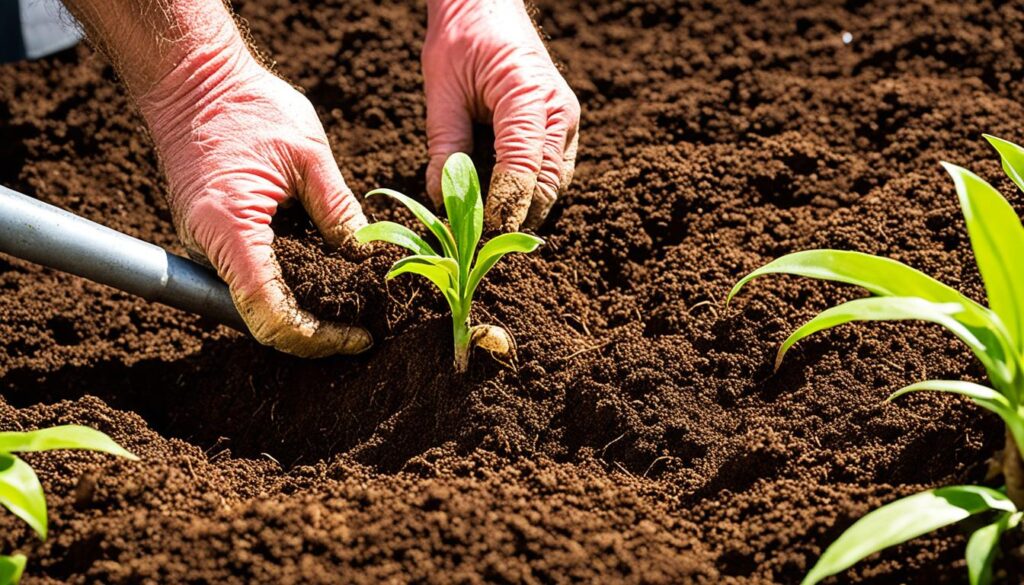
| Planting Technique | Advantages | Disadvantages |
|---|---|---|
| Using Whole Rhizomes | – Quicker growth – Larger harvests |
– Requires more planting material – Limited control over spacing |
| Using Cut Rhizome Pieces | – Maximizes planting material – Allows for precise spacing |
– Slower initial growth – Smaller rhizome yields |
| Pre-sprouting Indoors | – Provides an early start – Enhances germination rates |
– Requires additional indoor space – Requires regular misting |
Care Tips for Ginger Root Growth
Proper care is crucial for the successful growth of ginger roots. By providing the right conditions, you can ensure healthy plants and a bountiful harvest. Here are some essential care tips for ginger root growth:
1. Warmth: Ginger plants thrive in warm environments, so it’s important to provide them with a suitable temperature. During the summer, whether you are growing ginger outdoors or indoors, it’s beneficial to place the plants in a warm and humid area.
2. Humidity: Humidity is another important factor for ginger root growth. If you are growing ginger indoors, placing the plant near a bright windowsill can help simulate the ideal conditions. Additionally, occasional misting with water can create a humid environment that mimics the plant’s natural habitat.
3. Moisture: Adequate moisture levels are essential for ginger plants. It’s important to water the plants regularly, ensuring that the soil is evenly moist. However, be cautious not to overwater, as excessive moisture can lead to root rot. To promote proper drainage, use pots with drainage holes and allow the soil to dry out slightly between waterings.
4. Mulching: Applying a layer of mulch around ginger plants can serve multiple benefits. Mulching helps to conserve moisture in the soil, reducing the frequency of watering required. Additionally, it helps to suppress weed growth, keeping the area around the ginger plants clean and tidy.
Ginger plants require a combination of warmth, humidity, moisture, and proper drainage to thrive. By following these care tips, you can create optimal conditions for ginger root growth and enjoy a successful harvest.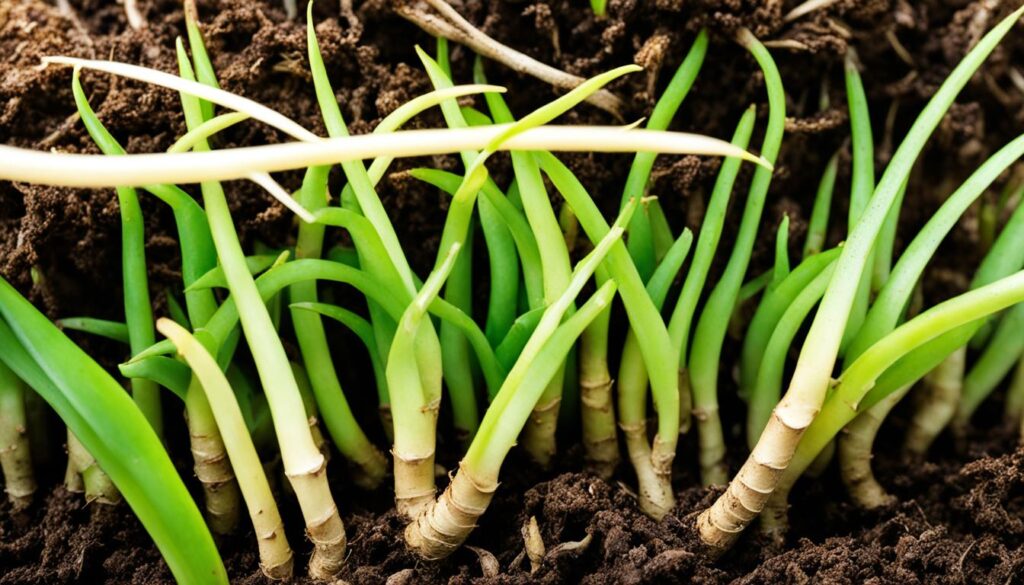
| Care Tips for Ginger Root Growth | Benefits |
|---|---|
| Provide warmth | Creates a favorable environment for ginger plants |
| Maintain humidity | Simulates the plant’s natural habitat and supports growth |
| Ensure proper moisture | Prevents drying out or waterlogging |
| Use mulch | Conserves moisture and suppresses weed growth |
Conclusion
Growing ginger successfully requires replicating its tropical natural habitat as closely as possible. Providing optimal soil conditions, the right temperature range, adequate moisture, and dappled shade is crucial. By following these best practices, gardeners can ensure the best conditions for ginger root growth and enjoy a bountiful harvest.
When it comes to planting ginger, there are two main methods: using whole rhizomes or cutting them into pieces and pre-sprouting indoors for an earlier harvest. Both approaches can be effective, but it’s important to pay careful attention to watering and drainage. Ginger cannot tolerate standing water or drying out completely, so finding the right balance is key.
Remember that ginger thrives in warm temperatures, ideally ranging from 70° to 90°F (21° to 32°C). Additionally, ginger plants appreciate some dappled shade, as it protects them from direct sunlight and helps prevent the soil from drying out too quickly. Creating these optimal conditions will give your ginger the best chance to grow and thrive.
So whether you’re growing ginger in the ground, in containers, or in a greenhouse, make sure to provide it with the right environment. By replicating its tropical natural habitat as closely as possible and paying attention to its specific needs, you can enjoy a bountiful harvest of delicious and aromatic ginger roots.
FAQ
What are the best conditions for ginger root growth?
What are the optimal soil conditions for ginger root growth?
What is the ideal temperature range for ginger root growth?
How important is moisture for ginger root growth?
What are the benefits of dappled shade for ginger root growth?
What are the recommended planting techniques for ginger root growth?
What are the care tips for ginger root growth?
- About the Author
- Latest Posts
Meet Katherine, the creative enthusiast at ByRetreat who infuses her boundless passion for design into every remote workspace she crafts. With an innate sense of creativity and an eye for unconventional beauty, Katherine brings a unique and inspiring perspective to the team.
Katherine’s love for design is infectious, and her ability to think outside the box sets her apart. She believes that true artistry lies in embracing a variety of styles and mixing them harmoniously to create captivating spaces. By combining different textures, colors, and patterns, Katherine weaves a tapestry of creativity that breathes life into each remote workspace.
-

 Vetted5 days ago
Vetted5 days ago15 Best Printers of 2024: Top Picks and Expert Reviews
-

 Vetted1 week ago
Vetted1 week ago15 Best Tile Sealers for Long-Lasting Protection and Shine
-

 Vetted2 weeks ago
Vetted2 weeks ago15 Best Smelling Floor Cleaners That Will Leave Your Home Fresh and Inviting
-

 Vetted1 week ago
Vetted1 week ago14 Best Power Scrubbers for Showers That Will Transform Your Cleaning Routine
-

 Vetted2 days ago
Vetted2 days ago15 Best Evergreen Plants for Shade Gardens: A Complete Guide
-

 Vetted2 days ago
Vetted2 days ago15 Best LED Dimmer Switches With No Flicker: Ultimate Guide for a Flicker-Free Lighting Experience
-

 Mardi Gras Decoration4 days ago
Mardi Gras Decoration4 days agoWhat Do the Symbols of Mardi Gras Mean?
-

 Appliances1 week ago
Appliances1 week ago5 Best Energy-Efficient Stainless Steel Fridges 2023




























